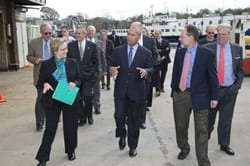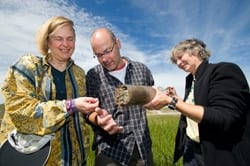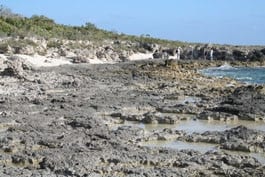Press Room
The research vessel Atlantis, operated by Woods Hole Oceanographic Institution (WHOI), rescued 93 Egyptians aboard a disabled fishing boat in the Mediterranean Sea late Friday night (Nov. 25).
Woods Hole Oceanographic Institution (WHOI) Executive Vice President and Director of Research Larry Madin will join Massachusetts Governor Deval Patrick and a coalition of business executives, academic leaders, and government officials on the Massachusetts-Brazil Innovation Economy Mission 2011 this December to pursue job growth and economic development partnerships between Massachusetts and Brazil.
Global warming could destabilize the pool of carbon in the Ganges-Brahmaputra basin and similar places on Earth, potentially increasing the rate of CO2 release into the atmosphere.
A WHOI-led project is one of several major awards recently announced by the National Science Foundation’s (NSF) Dimensions in Biodiversity research program. The multi-disciplinary, international collaborative effort will advance our understanding of deep-sea hydrothermal vent microbial communities and their global impact.
WHOI and the Consortium for Ocean Leadership announced McLane Research Laboratories, of East Falmouth, Mass., will provide the Wire Following Profilers for the Coastal and Global Scale Nodes component of the Ocean Observatories Initiative (OOI) program. WHOI, as implementing organization…
In a study published online in the Proceedings of the Royal Society B, a team that includes researchers from the Woods Hole Oceanographic Institution (WHOI) has confirmed that bubbles do form in live, stranded dolphins. But in many cases, those animals are able to manage those bubbles and can resume relatively normal lives of swimming and diving in the ocean.
WHOI and the Consortium for Ocean Leadership have awarded a contract to Pro-Oceanus Systems, Inc., of Bridgewater, Nova Scotia, Canada, to provide Partial Pressure of CO2, or p(CO2) , air-sea instrument packages for the Coastal and Global Scale Nodes component of the Ocean Observatories Initiative program.
Woods Hole Oceanographic Institution (WHOI) scientists have discovered that bacterial communication could have a significant impact on the planetÃÂs climate.
The Woods Hole Oceanographic Institution (WHOI) hosted a visit Wednesday, October 12, by Massachusetts Governor Deval Patrick, marking his first visit to the Cape-based non-profit ocean research, engineering, and education organization. “The Institution is honored to host the governor,” said…
The Woods Hole Oceanographic Institution (WHOI) has signed a $1.18 million agreement with the Flatley Discovery Lab in Charlestown, Mass., to investigate and supply marine microbial extracts as possible treatments for cystic fibrosis (CF).
Scientists from the Marine Biological Laboratory (MBL) and the Woods Hole Oceanographic Institution (WHOI) were recently awarded a $1.2 million collaborative grant from the National Science Foundation (NSF) for studies on the role of sulfur-oxidizing bacteria in salt marsh nitrogen and carbon cycling. The fieldwork will be conducted at the Plum Island Ecosystem Long-Term Ecological Research (LTER) site on the North Shore of Boston.
New evidence of sea-level oscillations during a warm period that started about 125,000 years ago raises the possibility of a similar scenario if the planet continues its more recent warming trend, says a research team led by the Woods Hole Oceanographic Institution (WHOI).
The New Bedford Whaling Museum is the backdrop for a free community event ÂPioneering New Ocean Science Frontiers on Saturday, September 17, from 10 a.m.  2 p.m., co-sponsored by the Woods Hole Oceanographic Institution and the Consortium for Ocean Leadership. The Whaling Museum is located at 18 Johnny Cake Hill, New Bedford, Mass.
In a detailed assessment of the Deepwater Horizon oil spill, researchers led by a team from the Woods Hole Oceanographic Institution (WHOI) have determined that the blown-out Macondo well spewed oil at a rate of about 57,000 barrels a day, totaling nearly 5 million barrels of oil released from the well between April 20 and July 15, 2010, when the leak was capped. In addition, the well released some 100 million standard cubic feet per day of natural gas.
An international team of researchers, including physical oceanographers from the Woods Hole Oceanographic Institution (WHOI), has confirmed the presence of a deep-reaching ocean circulation system off Iceland that could significantly influence the oceans response to climate change in previously unforeseen ways.
On Monday, Aug. 15, U.S. Senator Scott Brown visited the Woods Hole Oceanographic Institution (WHOI), the world-renowned research and education organization based on Cape Cod. The visit was Browns first to WHOI.
WHOI researchers have embarked on a 10-day mission to provide the first underwater, 3-D optical survey of ships sunk by German U Boats during World War II off the North Carolina coast.
Changes in ocean chemistry due to increased carbon dioxide (CO2) emissions are expected to damage shellfish populations around the world, but some nations will feel the impacts much sooner and more intensely than others, according to a study by scientists at Woods Hole Oceanographic Institution (WHOI).
On Sunday, August 7, from 11 a.m. to 3 p.m., the Woods Hole Oceanographic Institution (WHOI) will host a free community event featuring a rare opportunity to tour the oceanographic research vessel Knorr. The ship is best known as the one used in the discovery of the wreck of the Titanic and of the first hydrothermal vents. Visitors to the event will also be able to attend talks by one of KnorrÂs former captains and scientists who have used it to study the worldÂs ocean..
In the first published study to explain the role of microbes in breaking down the oil slick on the surface of the Gulf of Mexico, Woods Hole Oceanographic Institution (WHOI) researchers have come up with answers that represent both surprisingly good news and a head-scratching mystery.



